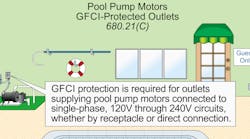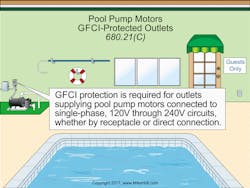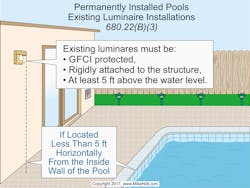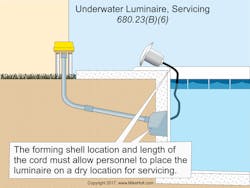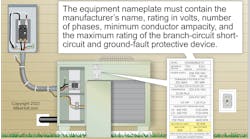All references are based on the 2017 edition of the NEC.
The installation requirements in Art. 680 Part I apply generally to pools, tubs, fountains, and spas. The requirements specific to permanently installed pools are outlined in Part II.
Motors
Where branch-circuit wiring for pool-associated motors is subject to physical damage or exposed to damp, wet, or corrosive locations, you must use one of the following: rigid metal conduit (RMC), intermediate metal conduit (IMC), rigid polyvinyl chloride conduit, and reinforced thermosetting resin conduit, or Type MC cable listed for the location [680.21(A)(1) and 680.14(B)]. This requirement is new with the 2017 NEC.
The wiring methods must contain an insulated copper equipment grounding conductor (EGC) sized per Sec. 250.122, based on the rating of the circuit overcurrent protective device (OCPD). In no case can the EGC be smaller than 12 AWG.
Wiring in dry and noncorrosive locations can use any Chapter 3 wiring method. The wiring to a pool-associated motor must comply with these rules unless modified for specific circumstances, such as:
• Flexible connections. Liquidtight flexible metal conduit (LFMC) or liquidtight flexible nonmetallic conduit (LFNC) with listed fittings is permitted [680.21(A)(2)].
• Cord and plug connections. Cords for pool motors are permitted if not longer than 3 ft and the cord contains a copper EGC, sized per Sec. 250.122; it must be based on the OCPD rating, but not smaller than 12 AWG [680.21(A)(3)].
GFCI protection is required for outlets supplying pool pump motors connected to single-phase, 120V through 240V branch circuits, whether by receptacle or by direct connection [680.21(C)] (Fig. 1).
Receptacles
Locate at least one 15A or 20A, 125V receptacle at least 6 ft and not more than 20 ft from the inside wall of the pool [680.22(A)(1)]. This receptacle can’t be more than 6½ ft above the floor, platform, or grade level serving the pool.
Receptacles for permanently installed pool motors, or other loads directly related to the circulation system, must be:
• At least 6 ft from the inside walls of the pool.
• GFCI protected.
• Of the grounding type [680.22(A)(2)].
Receptacles not for motors or other loads directly related to the circulation system must be at least 6 ft from the inside walls of the pool [680.22(A)(3)].
If within 20 ft from the inside walls of the pool, 15A and 20A, 125V receptacles must be GFCI protected [680.22(A)(4)].
Outdoor dwelling unit receptacles must be GFCI protected, regardless of their distance from the pool [210.8(A)(3)].
Outdoor 15A and 20A, 125V receptacles for nondwelling units require GFCI protection [210.8(B)(4)].
The receptacle distance is measured as the shortest path an appliance flexible cord would follow without passing through a wall, doorway, or window [680.22(A)(5)].
Luminaires and fans
New luminaires and ceiling fans installed above the water, or the area extending within 5 ft horizontally from the inside walls of the pool, can’t be less than 12 ft above the maximum water level [680.22(B)(1)].
Existing luminaires located less than 5 ft horizontally from the inside walls of the pool must be:
• At least 5 ft above the surface of the maximum water level.
• Rigidly attached to the existing structure.
• GFCI protected [680.22(B)(3)] (Fig. 2).
New luminaires installed between 5 ft and 10 ft horizontally from the inside walls of the pool must be GFCI protected, unless installed at least 5 ft above the maximum water level and rigidly attached to the existing structure adjacent to (or enclosing) the pool [680.22(B)(4)].
Listed luminaires can be less than 5 ft from the inside walls of the pool [680.22(B)(6)] if they:
• Don’t require grounding (they meet the low-voltage contact limit).
• Are supplied by listed transformers or power supplies that comply with Sec. 680.223(A)(2)
Underwater luminaires
Transformers and power supplies for underwater luminaires must be listed, labeled, and identified for swimming pool use [680.23(A)(2)].
GFCI protection is required for branch circuits that supply underwater luminaires operating at voltages greater than the low-voltage contact limit [680.2 definition] of 15V for sinusoidal alternating current, 21.20V peak for nonsinusoidal alternating current, 30V for continuous direct current, and 12.40V peak for direct current interrupted at a rate of
10 Hz to 200 Hz or less [680.23(A)(3)].
Underwater luminaires must be installed so the top of the luminaire lens isn’t less than 18 in. below the normal water level [680.23(A)(5)].
Forming shells
Forming shells for wet-niche underwater luminaires must have provisions for raceway entries [680.23(B)(1)]. Forming shells used with PVC conduit systems must include provisions for terminating an 8 AWG copper conductor. The raceway that extends directly to the underwater pool wet-niche forming shell must comply with Sec. 680.23(B)(a) or (b):
(a) Metal Raceway. Brass or corrosion-resistant RMC (not tubing) approved by the authority having jurisdiction (AHJ).
(b) Nonmetallic Raceway. A nonmetallic raceway to the forming shell must contain an 8 AWG insulated (solid or stranded) copper bonding jumper that terminates to the forming shell and junction box unless a listed low-voltage lighting system not requiring grounding is used.
The termination of the 8 AWG bonding jumper in the forming shell must be covered with a listed potting compound to protect the connection from the possible deteriorating effects of pool water.
The forming shell location and length of flexible cord must allow for personnel to place the removed luminaire on the deck or other dry location for maintenance. The luminaire maintenance location must be accessible without entering or going in the pool water [680.23(B)(6)] (Fig. 3).
Branch-circuit wiring
New with the 2017 NEC: Where branch-circuit wiring for underwater luminaires is installed in corrosive environments as described in Sec. 680.14, the wiring methods must comply with 680.14(B) or be LFNC. The wiring methods must contain an insulated copper EGC sized per Sec. 250.122, based on the rating of the OCPD. In no case can it be smaller than 12 AWG [680.23(F)(1)]. In noncorrosive environments, any Chapter 3 wiring method is permitted.
Exception: If connecting to transformers or power supplies for pool lights, LFMC is permitted in individual lengths not exceeding 6 ft.
For other than listed low-voltage luminaires not requiring grounding, branch-circuit conductors for an underwater luminaire must contain an insulated copper EGC sized per Table 250.122, based on the rating of the OCPD, but not smaller than 12 AWG [680.23(F)(2)].
Junction boxes
The junction box (deck box) that connects directly to an underwater permanently installed pool luminaire forming shell must be [680.24(A)(1)]:
• Listed, labeled, and identified as a swimming pool junction box.
• Equipped with threaded entries or hubs or a nonmetallic hub.
• Constructed of copper, brass, or corrosion-resistant material approved by the AHJ.
And it must provide electrical continuity between metal raceways and grounding terminals within the box. Additional box requirements, including those for protection, strain relief, and grounding are in Sec. 680.24(B) through (F).
Equipotential bonding
The equipotential bonding requirements are crucial to safety because they reduce voltage gradients in the pool area [680.26]. Equipotential bonding isn’t required to extend to (or be attached to) any panelboard, service equipment, or grounding electrode.
The parts of a permanently installed pool listed in Sec. 680.26(B)(1) through (B)(7) must be bonded with a solid copper conductor at least 8 AWG with listed pressure connectors, terminal bars, exothermic welding, or other listed means per Sec. 250.8(A). These include conductive pool shells, perimeter surfaces, and metal fittings.
Pumps for storables
Cord-connected pool pumps must be double insulated and have a means to ground the internal metal parts to an EGC installed with the power-supply conductors in the flexible cord. The flexible cord must also have GFCI protection as an integral part of the attachment plug [680.31].
GFCI for storables
Pools aren’t magically rendered safe just because they are storable rather than permanently installed. Article 680 also has requirements for storable pools in Part III. An example of those requirements is that GFCI protection is required for electrical equipment associated with storable pools. It’s is also required for all 15A and 20A, 125V receptacles within 20 ft from the inside wall of a storable pool, storable spa, or storable hot tub [680.32].
Shock-free pools
We’ve covered most of the requirements for permanently installed swimming pools. Two principles that improve pool safety are distance and equipotential. You achieve correct distance, for example, by locating receptacles 6 ft to 20 ft from the inside wall of a permanently installed pool [680.22(A)(1)].
You achieve equipotential by bonding metallic objects. The bonding reduces the voltage between them to zero, so no current will flow. Take some time to see if you can identify the other principles that underlie the requirements of Art. 680.
Holt is the owner of Mike Holt Enterprises, Inc. in Leesburg, Fla. He can be reached at www.mikeholt.com.